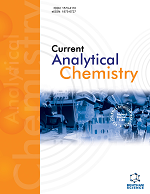- Home
- A-Z Publications
- Current Analytical Chemistry
- Previous Issues
- Volume 5, Issue 2, 2009
Current Analytical Chemistry - Volume 5, Issue 2, 2009
Volume 5, Issue 2, 2009
-
-
Editorial [Hot Topic: The Exciting Ionic Life of a Protein in the Hands of a Mass Spectrometrist (Guest Editor: Andrea Armirotti)]
More LessOver the last twenty years, biomolecular scientists learned to switch from the model to the result, from a design based on a four letter alphabet to the final twenty letters based outcome of the genetic project. From genome to the proteome. This important step was taken because the evolutive information is carried by a very rigid molecule, the DNA, and becomes effective in much more flexible objects, the proteins, whose che Read More
-
-
-
Protein Purification
More LessAuthors: William W. Ward and Gavin SwiatekThe science, art, and practice of protein purification have been with us for more than a century, yet, in many respects, the field is only now evolving past its adolescent roots. New methods are replacing old methods at such a dizzying pace, that even life-long experts in protein purification cannot keep up. In this article, we present many state-of-the-art protein purification techniques without totally ignoring the p Read More
-
-
-
High Resolution Protein Display by Two-Dimensional Electrophoresis
More LessAuthors: Gert V. d. Bergh and Lutgarde ArckensTwo-dimensional electrophoresis has, for many years, been the primary workhorse for performing functional proteomics, the large-scale analysis of protein expression differences. Despite its merits, limitations inherent to this technology have been recognized for a long time, ranging from its gel-to-gel variability to its inability to represent several classes of proteins. Recently, however, technical advances in two-dimensional electr Read More
-
-
-
Bottom-Up Proteomics
More LessIn this work, the “bottom-up” protein identification process is described, from sample digestion to the final database search result. Both MALDI and LC-MS approaches to the identification issue are illustrated. The state-of-the-art of these technique is outlined along with several recent applications, such as MSn data acquisition and chemical derivatization of peptides.
-
-
-
Mass Spectrometry Bioinformatics: Tools for Navigating the Proteomics Landscape
More LessAuthors: Kevin Blackburn and Michael B. GosheCentral to the successful implementation of a proteomics pipeline are appropriate bioinformatics tools to provide a level of automation and standardization to the qualitative identification of proteins, quantitation of protein changes, data capture and storage, and integration with other data platforms. Many of these efforts are in various stages of maturity; however, the identification, or recognition, of peptides/proteins f Read More
-
-
-
Analysis of Glycosylation and Other Post-Translational Modifications by Mass Spectrometry
More LessThe determination of post-translational modifications is one of the main challenges in proteomics research. Mass spectrometry is a powerful tool for the structural characterization of proteins and different mass spectrometric techniques for the analysis of post-translational modifications of individual proteins or protein populations have been developed. This review describes the most recent advances in mass spectrometry-b Read More
-
-
-
Advances in Quantitative Mass Spectrometry Analysis: Weighing in on Isotope Coding and Label-Free Approaches for Expression and Functional Proteomics
More LessAuthors: Ko-yi Chien and Michael B. GosheMass spectrometry is an extremely versatile analytical technique that is capable of characterizing proteins at various levels of biochemical sophistication from recognition of protein components and their modifications to their quantification within a sample. With the development of electrospray ionization and matrix-assisted laser desorption ionization, the last decade of protein analysis using mass spectrometry has f Read More
-
-
-
Protein Folding and Protein-Ligand Interactions Monitored by Electrospray Mass Spectrometry
More LessAuthors: Peter L. Ferguson, Mark C. Kuprowski, Brian L. Boys, Derek J. Wilson, Jingxi Pan and Lars KonermannElectrospray ionization (ESI) mass spectrometry (MS) has become an indispensable tool for studies on protein structure, folding, dynamics, and interactions. The ESI process generates intact and multiply protonated ions from proteins in solution. The charge state distribution of these ions provides a highly sensitive probe for the overall compactness of a protein in solution. Unfolded conformers lead to the formation of high Read More
-
-
-
Isotope Exchange and Covalent Modification Strategies for Studying Protein Structure and Function
More LessAuthors: Shugui Chen and John R. EngenMass spectrometry can be used to obtain information about all levels of protein structure. To gain access to the conformation information found in the tertiary and quaternary structure, various labeling methods have been developed. These methods convert structural information into mass differences that can be observed with high-resolution protein/ peptide mass spectrometry. Three methods are reviewed here: hydrogen/ Read More
-
Volumes & issues
-
Volume 21 (2025)
-
Volume 20 (2024)
-
Volume 19 (2023)
-
Volume 18 (2022)
-
Volume 17 (2021)
-
Volume 16 (2020)
-
Volume 15 (2019)
-
Volume 14 (2018)
-
Volume 13 (2017)
-
Volume 12 (2016)
-
Volume 11 (2015)
-
Volume 10 (2014)
-
Volume 9 (2013)
-
Volume 8 (2012)
-
Volume 7 (2011)
-
Volume 6 (2010)
-
Volume 5 (2009)
-
Volume 4 (2008)
-
Volume 3 (2007)
-
Volume 2 (2006)
-
Volume 1 (2005)
Most Read This Month
Article
content/journals/cac
Journal
10
5
false
en


